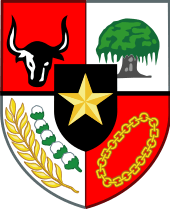Agriculture in Indonesia
Agriculture is one of the key sectors within the Indonesian economy. In the last 50 years, the sector's share in national gross domestic product has decreased considerably, due to the rise of industrialisation and service sector. Nevertheless, for the majority of Indonesian households, farming and plantation remains as a vital income generator. In 2013, the agricultural sector contributed 14.43% to national GDP, a slight decline from 2003's contribution which was 15.19%.[1] In 2012, the agricultural sector provides jobs to approximately 49 million Indonesians, representing 41% of the country's total labor force.[2]
Currently, approximately 30% of Indonesia's land area is used for agriculture. Indonesian agriculture sector is supervised and regulated by the Indonesian Ministry of Agriculture.[3]
The agricultural sector of Indonesia consists of:
- Large plantations, either owned by state or private companies;
- Smallholder production modes, mostly family owned and run by traditional agricultural households.
Industrial scale export commodities such as palm oil and rubber, are mainly supplied by large plantations, while the small scale farmers focus on horticultural commodities such as rice, corn, soybeans, fruits and vegetables in order to meet the food consumption of the local and regional population.[2]
Located in the tropical region, Indonesia enjoys abundant rain and sunshine most of the time, which are important elements for agricultural products to thrive. The country possesses vast and abundant arable fertile soils. As one of the world's major agricultural nation, the country offers wide diversity of tropical products and important agricultural commodities; which include palm oil, natural rubber, cocoa, coffee, tea, cassava, rice and tropical spices.[2]

At present, Indonesia is also the world's largest producer of palm oil,[4] cloves,[5] and cinnamon,[6] the 2nd largest producer of nutmeg[7] natural rubber[8][9] cassava[10] vanilla[11] and coconut oil,[12] the 3rd largest producer of rice[13] and cocoa,[14] the 4th largest producer of coffee.[15] the 5th largest tobacco producer.[16] and the 6th largest producer of tea.[17]
History
In Indonesian history, agricultural pursuits spanned for some millennia with some traces still observable in some parts of the archipelago. The hunter-gatherer society still exist in interior Kalimantan (Indonesian Borneo) and Papua (Indonesian New Guinea) such as the Kombai people,[18] while they were a sophisticated rice-cultivating community, the remnants of Hindu-Buddhist polity can still be observed in Bali through their subak irrigation system.[19]
Ancient era
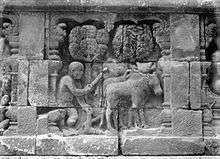
Agriculture in Indonesia started as a means to grow and provide food. Rice, coconut, sugar palm, taro, tubers, shallots and tropical fruits were among the earliest produce being cultivated in the archipelago. Evidence of wild rice cultivation on the island of Sulawesi dates back from 3000 BCE. Rice has been a staple food for Indonesians for a millennia[20] and holds a central place in Indonesian culture and cuisine.
The importance of rice in Indonesian culture is demonstrated through the reverence of Dewi Sri, the rice goddess of ancient Java and Bali.[21] Traditionally, the agricultural cycles linked to rice cultivation were celebrated through rituals, such as Sundanese Seren Taun or the "rice harvest festival." In Bali, the traditional subak irrigation system was created to ensure that there is adequate water supply for rice paddies. The irrigation system was managed by priests and created around "water temples".[19][22] Indonesian vernacular architecture also recognizes numbers of lumbung or rice barns styles, such as Sundanese leuit, Sasak style rice barn, Toraja's tongkonan shape, to Minangkabau's rangkiang.[23] Rice-growing shapes the landscape, is sold at markets, and is served in most meals.[22][24]

While some panels of the bas-reliefs on temple walls, such as Borobudur and Prambanan, describe agricultural activities, Javanese stone inscriptions which can be traced back from the 8th century, describes the king placing a levy on rice.[25] Next to rice, the bas-reliefs of Borobudur describe other indigenous agricultural products as well, like banana (musa paradisiaca), coconut (Cocos nucifera), sugarcane (Saccharum officinarum'), Java apple (Syzygium samarangense), jackfruit (Artocarpus heterophyllus), durian (Durio zibethinus) and mangosteen (Mangifera indica).[26]
Local kingdoms in Indonesia were among the earliest polities to participate in global spice trade. The ancient maritime empires of Srivijaya (7th to 11th century) and Majapahit (13th to 15th century) for example, were actively involved in spice trade with China, India and the Middle East. Ports of Sunda and Banten were important centers of pepper trade back in the 14th to 17th centuries.[27]
Colonial era
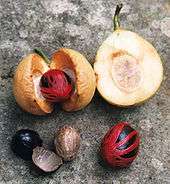
Certain endemic Indonesian spices such as nutmeg which is indigenous to the Banda Islands and cloves were highly sought in the West, and prompted the European Age of Exploration. The Portuguese were the earliest Europeans who established their presence in the archipelago by the early 16th century. The Portuguese, through Spanish intermediaries, introduced the New World's products such as chili pepper, maize, papaya, peanuts, potato, tomato, rubber and tobacco into the archipelago's soil.[28]
The surge of the global spice trade was what led European traders reach the Indonesian archipelago who were in search for direct sources of valuable spices, at the same time, cut through middlemen in Asia (Arabs and Indian merchants) and in Europe (Italian merchants). By the early 17th century, Dutch East India Company (VOC) began to establish its influence within the archipelago, by building trading offices, warehouses and forts in Amboina and Batavia.[29] By then, VOC monopolized the spice commodity trade, especially pepper and nutmeg,[30] and actively pursued its shares in intra-Asian trades with India and China. VOC further established sugar plantations in Java.[31]
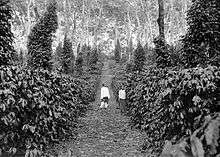
By the turn of the 19th century, VOC was declared bankrupt and was nationalized by the Dutch as Dutch East Indies. This event officially marked the Dutch colonial period in the archipelago.[32] In the mid-19th century, the Dutch East Indies government implemented cultuurstelsel which required a portion of agricultural production lands to be devoted to export crops. The cultivation system was enforced in Java and other parts of Indonesia by the Dutch colonial government between 1830 and 1870. Indonesian historians refer to it as Tanam Paksa ("Enforcement Planting"). The Dutch introduced numbers of cash crops and commodities to create and establish an economic engine in its colony. Establishment of sugarcane, coffee, tea, tobacco, quinine, rubber and palm oil plantations was also expanded in the colony.[33]
During the Dutch East Indies era, the agriculture sector was regulated by the Departement van Landbouw (1905), Departement van Landbouw, Nijverheid en Handel (1911) and Departement van Ekonomische Zaken (1934).[3]
Republic era
In 1942, Dutch East Indies fell under the control of the Japanese Empire. During the Japanese occupation, the agriculture sector was overseen by the Gunseikanbu Sangyobu.[3] During World War II (1942—1945), the Indies experienced hardships which included agricultural scarcity and famine. Rice yields and plantation commodities were controlled by the Japanese empire's military authority. The plantation business which was a major economic sector, was relatively shut down during the Pacific War and the ensuing Indonesian war of independence (1945—1949). All efforts in the agricultural sector was focused in meeting basic needs for food (rice) and clothing (cotton). The Imperial Japanese authority attempted to increase rice and cotton production in the occupied Indies by mobilizing labor. However, scarcity of these essential commodities prevailed and resulted to famine and clothing shortage.[34]
The Indonesian Republic declared its independence on 17 August 1945. Indonesia became a member of United Nation's Food and Agriculture Organization (FAO) in 1948. The partnership was strengthened with the opening of a FAO country office in 1978.[35] The agriculture sector of the republic has been supervised and regulated by the Indonesian Ministry of Agriculture.[3] The Indonesian Republic also nationalized many of its colonial economic infrastructures, institutions and businesses and inherited the agricultural system of its predecessor, the Dutch East Indies.
In the 1960s until the 1980s, the republic made every effort to develop a post-war agricultural sector and led to the sector's significant expansion. During the Suharto era, the government launched the transmigration program that relocated landless farmers from the overpopulated Java to the less populated Sumatra, Kalimantan, Sulawesi and Papua, thus expanded agricultural farms in the outer islands of the territory.[36]
The most significant indicator of growth is the expansion of palm oil plantations, which became the new form of transmigration program.[37] Currently, Indonesia is the world's largest producer of palm oil and the leading producer of coffee, rubber and cocoa. However, Indonesia still has vast tracts of idle lands which can potentially be developed into farmlands. These cover 40 million hectares of degraded forest areas that have turned into grasslands after being abandoned by logging concessionaires.
Agricultural commodities are known for its economic resilience and are among the first to recover from the impacts of global financial meltdown. With a large number of its population still working in the agriculture segment, Indonesia has great potentials of attracting foreign investments.[38]
Food products
The agriculture sector plays a vital role in food production and food security and in supplying the needs of a huge Indonesian population.[39]
Rice

Rice is a staple food in the Indonesian diet,[20] as typical Indonesian meal consists of richly flavored side dishes, meat or poultry and vegetables, surrounding a pile of steamed rice. Indonesia is the 3rd largest rice producer in the world after China and India. However, because of Indonesia's large population, the rice it produces is consumed internally.
As a vital necessity for Indonesian households, the government is responsible to regulate rice price and availability through Indonesian Bureau of Logistics (Bulog), which ensure its continuous supply and price stability. To ensure food security, the government fills the gap by importing from neighboring countries like Thailand, Vietnam and Cambodia.[40]
Horticulture
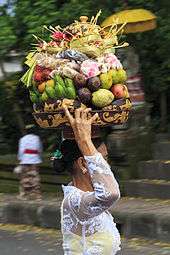
Horticulture, which covers fruits and vegetables production, holds an important role in the local Indonesian economy and in the attainment of food security. Indonesia possesses a variety of horticultural products. Its native fruits include durian, mangosteen, rambutan, salak, banana, jackfruit, mango, kedondong, jambu air, buni, jamblang and kecapi.[41] The bulk of fruits and vegetables needed by consumers are supplied by local traditional farmers. The products prices are highly dependent on seasonal availability and proximity to production centers, due to transportation and cargo infrastructure restrictions. As a result, prices of horticulture products vary greatly throughout Indonesia. Prices might be cheaper in Bandung and Bukittinggi as they are closer to horticulture farms but are significantly more expensive in Pekanbaru and Balikpapan which are located far from production centers. Recently, owing to a varied Indonesian topography, non-tropical horticultural products such as apple, strawberry, honeydew, grapes and dragon fruit are grown in the cooler mountainous region of Indonesia. The mountainous region around Malang in East Java is the production center for apple and dragon fruit, while those around Bandung in West Java are the production centers for strawberry, honeydew and mushroom.[42]

Despite its being home to the world's 4th largest population making it a huge market for horticultural products, the horticultural sector in Indonesia is deemed as under-performing which leads to the necessity of importing fruits and vegetables.[43] Local Indonesian farmers face a difficult situation — the imported horticultural products are often cheaper and has a better quality than the locally grown one.[44] Compared to neighboring countries with a well-developed horticultural sector like Thailand, Indonesia has much to improve. Currently, Indonesia imports much of its horticultural needs from Thailand (durian, carrot and chili pepper), China (garlic, orange and pear) and from the United States (soybean and apple). To protect local farmers, the Indonesian government applied protectionist policies on import settings for horticultural products, as well as restricting ports of entry.[45]
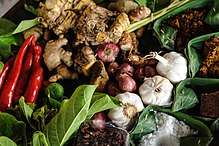
Spice is an essential element in Indonesian cuisine. In Indonesian, spice is called rempah, while the mixture of spices is called bumbu, they are chopped finely or ground into paste using traditional stone mortar and pestle, and spread over vegetables, meat, poultry, fish and seafood to add aroma and taste.[46] Known throughout the world as the "Spice Islands", the Indonesian islands of Maluku contributed to the introduction of its native spices to the world. Spices such as pala (nutmeg/mace), cengkeh (clove), daun pandan (Pandan leaves), kluwek (Pangium edule) and laos (galangal) are native to Indonesia. However, surprisingly nutmeg, mace and cloves are seldomly used in Indonesian cuisine.[47]
It is likely that lada hitam (black pepper), kunyit (turmeric), sereh (lemongrass), salam koja (curry leaf), bawang merah (shallot), kayu manis (cinnamon), kemiri (candlenut), ketumbar (coriander), and asam jawa (tamarind) were introduced from India or mainland Southeast Asia, while jahe (ginger), daun bawang (scallions) and bawang putih (garlic) were introduced from China. Those spices from mainland Asia were introduced early, in ancient times, thus they became integral ingredients in Indonesian cuisine. While the New World spices such as chili pepper and tomato were introduced by Portuguese and Spanish traders during the age of exploration in the 16th century.[46][48]
Commodities
Palm oil
Indonesia is both the world's biggest producer and consumer of the commodity, providing about half the world supply. Oil palm plantations stretch across 6 million hectares. Palm oil is the essential ingredients to produces cooking oil, as well as other food and cosmetics products. The country also aimed to be the largest palm-based biofuel production center.[49][50]
Coconut
Coconut plays an important role in Indonesian cuisine as well as its economy. Coconut milk is an important common ingredients in numbers of Indonesian favourites, including rendang and soto. According to figures published in December 2009 by the Food and Agriculture Organization of the United Nations, it is the world's second largest producer of coconuts, producing 15,319,500 tonnes in 2009.[51]
Rubber
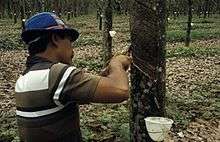
Indonesian rubber industry take its root in colonial Dutch East Indies; in the early 20th century the rubber plantation in the colony was booming, largely owed to the advent of natural rubber tire industry to supply the growing automotive industry in the United States and Europe.
Currently, Indonesia's rubber production is the world's second-largest after Thailand.[8] Natural rubber is an important export commodity that earn foreign exchange, with increasing production trend. In fact, ASEAN nations are among the largest natural rubber producers; the combined rubber yield of three ASEAN members — Thailand, Indonesia and Malaysia — accounts for nearly 66 percent of global total rubber production. However, compared to neighbouring countries, Indonesia's productivity level is lower (1,080 kg/ha), compared to Thailand (1,800 kg/ha), Vietnam (1,720 kg/ha) and Malaysia (1,510 kg/ha).
Majority of rubber estates in Indonesia are smallholder farmers, which retain for about 85 percent. This fact implied that the government and large private estates took a minor role in Indonesian rubber industry. Another problem is the lack of rubber processing facilities and manufacturing industry. In Indonesia, only a half of the natural rubber that is absorbed internally goes to the rubber products factories — while the rest are sold and exported as raw materials. Rubber processing facilities include tire manufacturing industry, followed by rubber gloves, rubber thread, footwear, retread tires, medical gloves, rubber carpets and various rubber tools.[52]
Coffee

In 2014, Indonesia was the fourth largest producer of coffee. Coffee in Indonesia began with its colonial history, and has played an important part in the growth of the country. Indonesia's geographic location is considered as ideal for coffee plantations. It is located near the equator and with numerous mountainous regions across the islands which creates suitable micro-climates for the growth and production of coffee.[53]
Indonesia produced an estimated 540,000 metric tons of coffee in 2014.[53] Of this total, estimated 154,800 tons was required for domestic consumption in the 2013–2014 financial year.[54] Of the exports, 25% are arabica beans; the balance is robusta.[55]
Tea
Indonesia is the world sixth largest tea producer. Tea production in Indonesia began in the 18th century, introduced by the Dutch as cash crop. Indonesia produced 150,100 tonnes of tea in 2013. However, 65% of that was exported from the country, which suggests Indonesians relatively low tea consumption. Large parts of tea produced in Indonesian mainly is black tea, although small amounts of green tea are also produced. Moreover, most of Indonesian tea varieties do not enjoy global recognition, thus much of them are merely used in blends — mixed with other teas.[17]
Environmental issues
As agricultural pursuits altered the natural landscapes; from rainforest, peat lands and swamps into arable lands, certainly it poses natural and environmental consequences. Environmental problems such as deforestation and forest and plantation fires, caused by forestry and agricultural sectors in Indonesia, continues to be a persisting problem that need to be addressed and solved.[57]
Deforestation
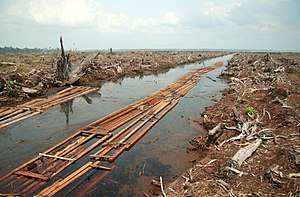
The deforestation in Indonesia is caused by logging industry, either legal or illegal, and in turn also contributed by the conversion of natural rainforest into agricultural lands, especially palm oil plantation.[58] The large-scale expansion of palm oil plantations has been accused as the culprit behind the clearance of Indonesian rainforests, which destroyed critical habitat for endangered species like rhinos, elephants, tigers and orangutans. Much of this endemic species have been pushed to the verge of extinction. This practice has raised international scrutiny on palm oil industry in Indonesia, especially from World Wide Fund for Nature, and raised the demand on sustainable palm oil production and certification.[59]
Forest and plantation fires
Indonesian palm oil plantations' poor practice and poor environmental responsibility, has led to massive haze problem annually. Since 1997 Indonesia has been struggling to contain forest fires, especially on the islands of Sumatra and Kalimantan. Haze occurs annually during the dry season and is largely caused by illegal agricultural fires due to slash-and-burn practices in Indonesia, especially in the provinces of South Sumatra and Riau on Indonesia's Sumatra island, and Kalimantan on Indonesian Borneo.[60][61][62] The haze that occurred in 1997 was one of the most severe; dense hazes occurred again in 2005, 2006, 2009, 2013, and the worst was in 2015, killing dozens of Indonesians as a result of respiratory illnesses and road accidents due to poor visibility.[63][64][65][66][67]
See also
References
- Estu Suryowati (12 August 2014). "Satu Dekade, Kontribusi Pertanian terhadap PDB Menurun". Kompas (in Indonesian).
- "Pertanian di Indonesia (Agriculture in Indonesia)". Indonesia Investments. Retrieved 5 December 2015.
- "Sejarah Kementerian Pertanian". Kementerian Pertanian RI (Indonesian Ministry of Agriculture) (in Indonesian). Archived from the original on 2015-12-21. Retrieved 2015-12-07.
- "Palm Oil Production by Country in 1000 MT". Index Mundi.
- "Top Production, Cloves, 2012". FAOSTAT. Archived from the original on 2011-07-13.
- "Top Production, Cinnamon (canella), 2012". FAOSTAT. Archived from the original on 2011-07-13.
- "Top Production, Nutmeg, mace and cardamoms, 2012". FAOSTAT. Archived from the original on 2011-07-13.
- "Top Production, Rubber, natural, 2012". FAOSTAT. Archived from the original on 2011-07-13.
- "Chemical Economics Handbook, Natural Rubber". IHS. July 2014.
- "Top Production, Cassava, 2012". FAOSTAT. Archived from the original on 2011-07-13.
- "Top Production, Vanilla, 2012". FAOSTAT. Archived from the original on 2011-07-13.
- "Coconut Oil Production by Country in 1000 MT". Index Mundi.
- "Top Production, Rice Paddy, 2012". FAOSTAT. Archived from the original on 2011-07-13.
- "Top 10 Cocoa Producing Countries". World Atlas.
- "Top 10 Coffee Producing Countries (2014)". World Atlas. Archived from the original on 2015-12-05. Retrieved 2015-12-04.
- "Leading 10 tobacco producing countries worldwide in 2013 (in 1,000 metric tons)". Statista.
- "The Worlds Top 10 Tea Producing Nations". World Atlas.
- "The Kombai". BBC.
- "Cultural Landscape of Bali Province: the Subak System as a Manifestation of the Tri Hita Karana Philosophy". UNESCO.
- Taylor, Jean Gelman (2003). Indonesia: Peoples and Histories. New Haven and London: Yale University Press. pp. 8–9. ISBN 0-300-10518-5.
- Suwardi. "Land Management, the Myth of Dewi Sri, and the Balance of Javanese Cosmology, an Anthropogeographic Overview". UGM.
- Forshee, Jill (2006). Culture and Customs of Indonesia, Culture and customs of Asia. Greenwood Publishing Group. p. 129. ISBN 978-0-313-33339-2.
- "The Museum's iconic hallmark – a Rice Barn from Indonesia". Rautenstrauch-Joest Museum. Köln.
- "Indonesian Food: A Memorable Southeast Asian Cuisine". Living in Indonesia.
- Degroot, Véronique (2009). Candi, Space and Landscape: A Study on the Distribution, Orientation and Spatial Organization of Central Javanese Temple Remains. Leiden: Sidestone Press, Issue 38 of Mededelingen van het Rijksmuseum voor Volkenkunde. p. 100. ISBN 978-90-8890-039-6.
- Ary Sulistyo (April 2, 2014). "Ekologi Manusia dan Lansekap Desa Di Indonesia". IPLBI (in Indonesian). Archived from the original on July 3, 2014. Retrieved January 14, 2016.
- Novani Nugrahani (October 15, 2015). "Museum Week to highlight spice trail". The Jakarta Post. Jakarta. Archived from the original on December 10, 2015. Retrieved December 8, 2015.
- Forshee, Jill (2006). Culture and Customs of Indonesia, Culture and customs of Asia. Greenwood Publishing Group. p. 128. ISBN 978-0-313-33339-2.
- "602 Trade with the East: VOC". Rijkmuseum. Archived from the original on 2016-03-05. Retrieved 2016-01-14.
- Miss Cellania (August 6, 2012). "The Nutmeg Wars". Neatorama.
- Bosma, Ulbe (2013). The Sugar Plantation in India and Indonesia: Industrial Production, 1770–2010, Studies in Comparative World History. Cambridge University Press. p. 15. ISBN 978-1-107-03969-8.
- "1820–1950 Indonesia and decolonisation". Rijkmuseum. Archived from the original on 2016-03-05. Retrieved 2016-01-14.
- Parulian Silaen (2006). "The "Culture System" in Dutch Indonesia 1830–1870: How Rawls's Original Position Ethics were Violated". University of Wollongong.
- Shigeru Sato. "Labour Relations in Japanese Occupied Indonesia" (PDF). CLARA Working Paper, No. 8.
- "Indonesia and FAO" (PDF). FAO (pdf).
- M.Adriana Sri Adhiati and Armin Bobsien (ed.) (July 2001). "Indonesia's Transmigration Programme - An Update". Down To Earth.CS1 maint: extra text: authors list (link)
- Potter, Lesley. "Oil Palm and the New Transmigration in Indonesiaː Examples from Kalimantan" (PDF). Australian National University, Resource Management in Asia Pacific Program.
- Simbolon, Johannes (November 14, 2010). "The rise of agriculture and Indonesia's future". Jakarta. Retrieved 7 December 2015.
- "Indonesia". Food Security Portal.
- "Jokowi finally agrees to import rice from Thailand, Vietnam". The Jakarta Post. Jakarta. October 22, 2015.
- "10 Great Balinese Fruits". Bali Indonesia Magazine.
- Vira Zoelfikar (October 21, 2013). "Picking strawberries in Lembang". The Jakarta Post Travel. Archived from the original on December 11, 2015. Retrieved December 8, 2015.
- "Organic Growth – Horticulture in Indonesia". Global Business Guide. Retrieved 7 December 2015.
- "Indonesia's Horticultural Products and the Trade Ministry's Regulatory Framework". Indonesia Investment. 6 May 2013. Retrieved 7 December 2015.
- Ida Nurcahyani (7 October 2013). "Indonesia-Thailand bahas kebijakan impor produk hortikultura". Antara (in Indonesian).
- "Herbs and Spices, The most important part of Indonesian cooking". Discover Java and Bali. Retrieved 8 December 2015.
- "Indonesia: Spices". Global Gourmet. Archived from the original on 2015-12-08. Retrieved 8 December 2015.
- "Bumbu". Spices of India.
- McClanahan, Paige (11 September 2013). "Can Indonesia increase palm oil output without destroying its forest? Environmentalists doubt the world's biggest palm oil producer can implement ambitious plans without damaging woodland". The Guardian. Retrieved 22 September 2013.
- "Indonesia Palm Oil Production by Year". Index Mundi.
- "Food And Agriculture Organization of the United Nations". Economic And Social Department: The Statistical Division. Archived from the original on 2013-01-14.
- "Rubber Industry Indonesia: Challenges and Opportunities". Indonesia Investments. 22 April 2015.
- "Total production by all exporting countries" (PDF). International Coffee Organization (pdf).
- USDA GAIN (2014). Indonesia Coffee Annual 2014, Global Agricultural Information Network (GAIN), USDA Foreign Agricultural Service. Available at: http://gain.fas.usda.gov/Recent%20GAIN%20Publications/Coffee%20Annual_Jakarta_Indonesia_5-14-2014.pdf
- "Trade Statistics". Ico.org. Retrieved 2008-08-07.
- "Indonesia". Tobacco Free Center. Archived from the original on 2010-06-11. Retrieved September 3, 2010.
- Bustar Maitar (November 1, 2015). "4 Ways to Stop Indonesia's Forest Fires". Greenpeace.
- "Background information on Indonesia, deforestation and illegal logging". ABC. 2002. Archived from the original on 2016-01-16. Retrieved 2015-12-06.
- "Palm oil and deforestation". WWF.
- Soeriaatmadja, Wahyudi. "Minister blasts execs of firm that denied burning forest". The Straits Times. Archived from the original on 13 October 2015. Retrieved 13 October 2015.
- "What causes South East Asia's haze?". BBC News. 16 September 2015. Archived from the original on 3 October 2015. Retrieved 26 September 2015.
- "Southeast Asia's haze: what's behind the annual outbreaks?". Agence France-Presse. 17 September 2015. Archived from the original on 27 September 2015. Retrieved 26 September 2015.
- "Haze kills 10 people, leaves 503,874 with respiratory ailments". The Jakarta Post. October 24, 2015.
- Banda Haruddin Tanjung (18 September 2015). "Gara-Gara Kabut Asap, Biker Tewas Tabrak Mobil Pemadam" (in Indonesian). Okezone. Retrieved 18 September 2015.
- "Akibat Kabut Asap, Dua Tewas (Laka Tunggal, Tabrak Tiang Listrik)" (in Indonesian). Balikpapan Pos. 29 September 2015. Archived from the original on 2015-10-08. Retrieved 29 September 2015.
- Bangun Santoso (14 September 2015). "Tewas Akibat 'Tercekik' Asap" (in Indonesian). Liputan 6. Retrieved 14 September 2015.
- AMS (4 October 2015). Ini Daftar Korban Tewas Akibat Kabut Asap (video) (in Indonesian). Metro TV News. Event occurs at 10:24. Archived from the original on 6 October 2015. Retrieved 6 October 2015.
External links
| Wikimedia Commons has media related to Agriculture in Indonesia. |
